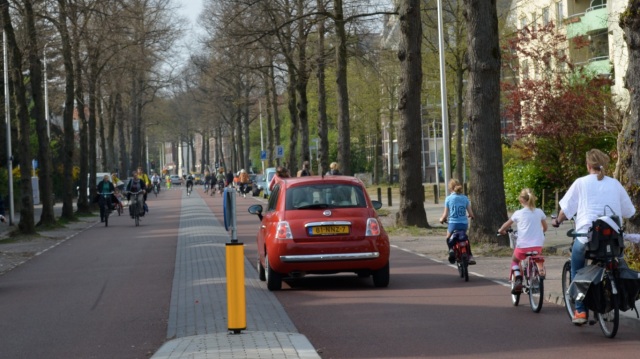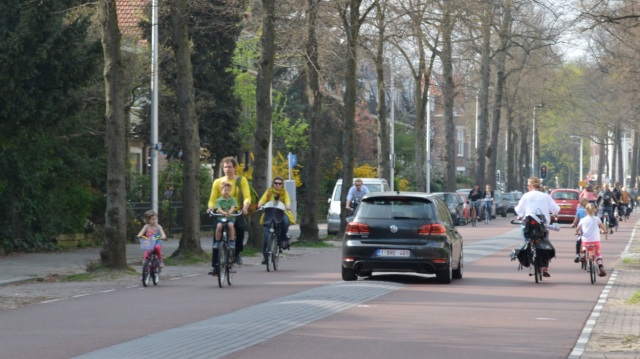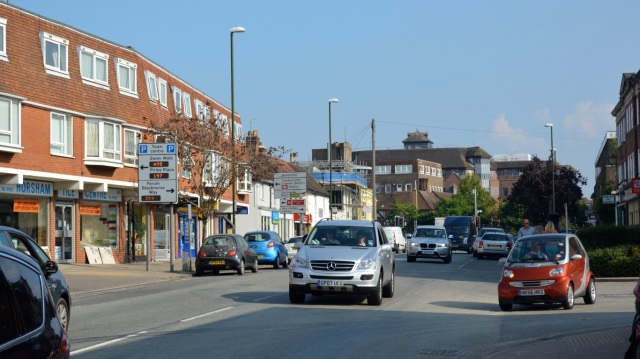Imagine a street that carries 14,000 cyclists a day, on the street itself. That equates to around 1,500 people cycling along the street per hour, or 25 every minute.
Imagine driving down that street. Surely a nightmare for any self-respecting driver who wants to make progress. A miserable experience. You’d never be able to overtake, what with all the cyclists trundling in front of you, often two or three abreast, taking up the whole road.
Well… no. Actually overtaking in a car on this street is pretty easy.
 … It’s even easy to overtake with people cycling two abreast, in both directions.
… It’s even easy to overtake with people cycling two abreast, in both directions.
 Even a very wide three abreast doesn’t present a significant problem.
Even a very wide three abreast doesn’t present a significant problem.
How on earth can it be easy to overtake when there are so many bloody cyclists in the middle of the road?
The answer is quite simple – the reason drivers can overtake easily is because there aren’t many other drivers using this street.
Take a look at the photographs again. There isn’t oncoming motor traffic to prevent an overtake. There’s also limited on-street parking (just one set of bays, on one side of the road, in designed bays) meaning the road itself is not obstructed by parked vehicles.
Quite clearly it is other motor vehicles – both moving and stationary – that makes overtaking difficult, because a vast amount of cyclists ‘clogging’ a road doesn’t necessarily represent an impediment to motoring progress.
To compare with a British example – struggling to overtake a cyclist heading away from the camera here?
 Or here? (Looking in the opposite direction on the same street)
Or here? (Looking in the opposite direction on the same street)
 That’ll be because of the large amount of oncoming motor traffic, preventing you from moving out into the opposing lane, and the amount of parking on both sides of the street, greatly reducing the available width of what is, in reality, a very wide road.
That’ll be because of the large amount of oncoming motor traffic, preventing you from moving out into the opposing lane, and the amount of parking on both sides of the street, greatly reducing the available width of what is, in reality, a very wide road.
Really, how could it be otherwise? How can a human being two feet wide, on a road that is 35 feet wide, …
 …. seriously present an impediment to progress, without other big blocky things (including the vehicle that you yourself are driving) greatly reducing the space available?
…. seriously present an impediment to progress, without other big blocky things (including the vehicle that you yourself are driving) greatly reducing the space available?
In reality, hell is other drivers – not other people people cycling.








Good article. It is amazing that so much fought-over road space is used for car storage.
It still tickles me how drivers will acceptingly sit in traffic jams for hours every week, but only get really infuriated when they have to hang back for fifteen seconds before passing a cyclist.
Definitely
“It still tickles me how drivers will acceptingly sit in traffic jams for hours every week, but only get really infuriated when they have to hang back for fifteen seconds before passing a cyclist.”
Especially as that cyclist on the road means that they will be one car closer to the front when they reach the next set of traffic lights.
Or this evening, on a road without many lights, when I had to wait 20 seconds to pass a cyclist and was then in a line of cars that took five miles to get past a tractor….
With Australian types of cars and cyclists I calculated that cars use roughly 6 times more space than a bicycle in congested conditions:
On the continent that would go up in favour of the cyclists substantially as people are accustomed to cycling in dense flow, but this only holds on slow streets such as those shared in the Netherlands.
Traffic engineering in London uses a figure of 0.2 PCU (Passenger Car Units) for a bike, so assumes 5 bikes per car on average.
Reblogged this on Vokesy and commented:
A great piece on why cyclists aren’t your problem!
yes overtaking there is easy with the hump/ramp thing. but comparing this to London where there are many deaths/accidents is not relevant. the volume of traffic in London is huge compared to this pseudo-residential road. anyway, recent police activity on transgressors in London at major lights led to the punishment of FAR more car drivers than cyclists. pedestrians too suffer far more from their stupidity (making phone calls and crossing roads for ex) in absolute numbers than cyclist. Still the bottom line is that we ALL need to pay more attention and chill out a bit an spread a little love
It could well be relevant to Horsham where the UK pictures are from (and similar urban/subsurban settings). Yet even here, with tiny cycling share, motorists will moan about being held up.
I disagree – the bottom line is we need to devote more road space to dedicated cycle infrastructure, and less to cars.
No matter how much I pay attention or chill out I’ll still be at risk from bad drivers (besides, surely the two things are contradictory – its hard to chill out while constatantly looking out for people who might be about to kill you!)
This might look like a ‘residential road’ but I think you are letting the absence of motor traffic fool you into thinking this isn’t a major route for *people*.
As the post says, this street carries 14,000 people cycling, every day. In the UK that would equate to around 10,000 motor vehicles, given an occupancy rate of 1.5 people per car. Not so ‘residential’.
This is kind of the point of the post, actually – ‘busy’ roads that are difficult to overtake on suddenly become much less ‘busy’ and ‘difficult’ when the traffic on them is mostly composed of bicycles.
Pingback: Asalto a la hegemonía – Alertaciclista